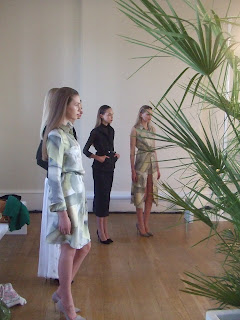After the lows of wartime America and indeed the rest of the world, America experienced a boom during the 1920s and this was reflected instantly through clothing of the young crowd. Strongly connected to a dislike of prohibition, Chanel’s loose-fitting, garçonne look became a symbol of progressive young women, challenging the morals and ideals of past generations.
After the end of the war, men were returning home to an America in which industry had had a strong female dominance whilst they had been away serving their country. These men were affected and broke, thus had no hope of offering marriage to their sweethearts. There was much less security for women and having tasted freedom during the war, they were reluctant to return to the domestic role that had preceded the war. Fashion in the 1920s reflected this greatly and women used clothes to show off femininity rather than wear practical clothes representing their domestication.

The look that dominated the early 1920s was the garçonne style, which subsequently became known as the flapper look in prohibition America. It was the antithesis of the romantic look that had prevailed and it was largely owed to Coco Chanel. 1921 saw the launch of French Vogue that meant overseas sales of Parisian styles rocketed and America couldn’t wait to get their hands on this new aspirational style. The term garçonne is thought to originate from the 1922 novel La Garçonne by Victor Margueritte about an ambitious young woman who leaves her family to pursue independence, an ideal model for post-war women who were struggling to fit back into their roles of domestic goddess.
Chanel’s loose-fitting, garçonne look became a symbol of progressive young women
The clothes themselves directly reflected this aspirational, independent attitude with a boyish shape, moving away from the corseted hourglass figure that had been so popular pre-war. The notion that women discarded their corsets altogether is generally thought of as a myth, in fact, cylindrical elastic corsets were used to suppress the female curves and flatten chests. The drop-waisted dress became iconic in the 1920s, emphasising a boyish figure and lending themselves wonderfully to the ‘outrageous’ dances of the decade, such as the Charleston. The straight cut chemise dresses moved provocatively when the young ladies danced and exposed more leg than had ever been acceptable. Hemlines on skirts crept further up the leg as the decade drew on, sometimes exposing knees, meaning silk stockings, held up by garters were highly popular. This style became synonymous with the images of groups of young women out together.
In post-Sex and the City America, it is almost impossible to imagine that a group of young female friends out on the town, drinking, smoking and having casual sex was ever frowned upon. However, for young ladies to be seen out in the 1920s without a chaperone or a gentleman on one’s arm was challenging deep rooted divides between the sexes in society. By donning the flapper fashion, you were flaunting economic independence and modernity.
They were making a statement by their ever shorter hems, cutting their hair and drinking copious amounts of alcohol
Accessories were a key part of the flapper uniform and the cloche hat has become a symbol of this era. It was bell-shaped, made of felt and pulled deep over the brow. The shawl was also a must-have sign of wealth as they were often fringed with silk, but also provided some much needed warmth over flimsy 1920s gowns. Shoes had relatively high heels with cross straps or T-bars, perfect for dancing the night away underground in illegal bars. They were further embellished with embroidery or brocade to exude luxury. The final accessory which probably caused the greatest stir amongst traditionalists was the Eton crop, a daring schoolboy haircut, originating from Paris. Bobbed and shingled haircuts, made sleek and shiny by Brillantine, followed closely as a symbol of questioning authority. The girls pursuing this look advocated female voting and women’s rights and their freedom of expression came mainly through their fashion.

Blessed with the British high street in modern society, we expect saturated high end styles at our finger tips only weeks after they have been sent down the NY, London, Milan and Paris catwalks. At the beginning of the 1920s this was unheard of and style and glamour was something very much reserved for the upper classes. As the decade progressed, girls of all ages and social backgrounds were able to hone in on the accessible garçonne fashion as it was easy to make at home and mass produce. The material was very lightweight and the cut of the clothes was much more symbolic than the actual fabric, meaning one did not have to spend a fortune. The McCall Pattern Company started publishing patterns by Chanel, Vionnet, Patoo and Lanvin, to name but a few, hence the look infiltrating all walks of life. Girls were able to emulate the Hollywood screen stars even if their dress was rayon instead of Joan Crawford’s silk, couture gown. This, however, did not seem to matter to the young American girls; they were making a statement by their ever shorter hems, cutting their hair and drinking copious amounts of alcohol.
In post-Sex and the City America, it is almost impossible to imagine that a group of young female friends out on the town, drinking, smoking and having casual sex was ever frowned upon
The garçonne and flapper fashions were relatively short-lived, reaching a peak in 1926 and crashing out of society alongside Wall Street and the depression. By 1929, skirts had become longer, materials more practical and the hedonism of the 1920s dispersed with. For a moment in 1920s America, girls had used high heels and the tilt of a hat to give the illusion of wealth, of abundance and of being like a Hollywood starlet.























